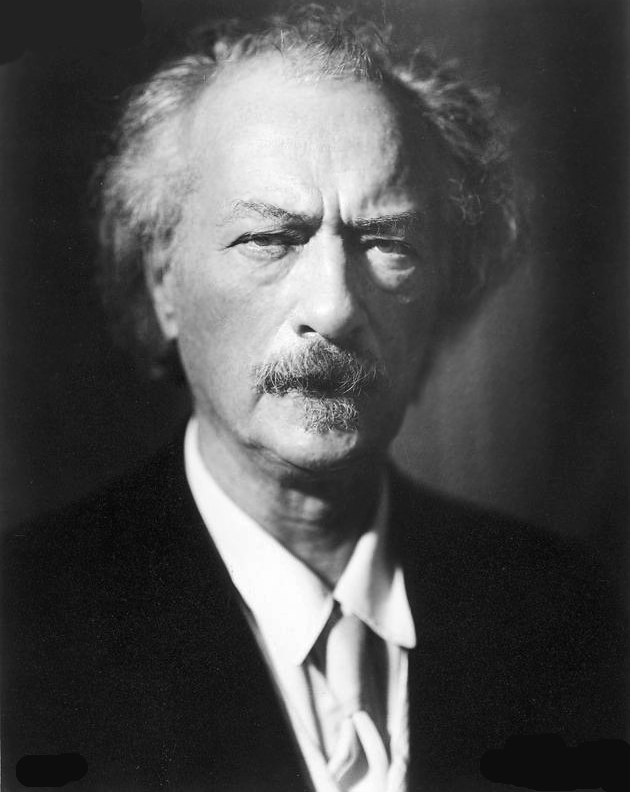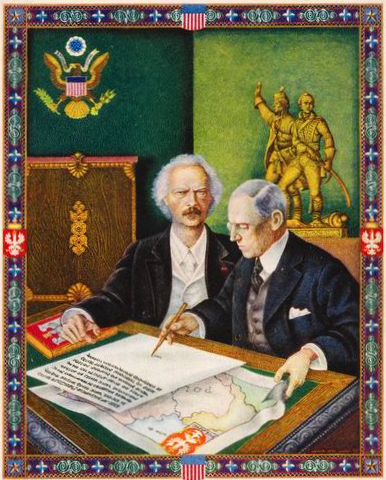2020 Remembering Paderewski
 Ignacy Jan Paderewski ca.1936
Ignacy Jan Paderewski ca.1936(public domain, Wikimedia Commons)
The Extraordinary Ignacy Jan Paderewski is Born – 160 Years Ago
Ignacy Jan Paderewski was born on November 6, 1860 in the village of Kurylowka in Russian-ruled Podolia. A recognized child prodigy at the piano at age three, in 1872 he was sent by his father, a participant in the 1863 Polish insurrection against Russia, to study at the Warsaw Conservatory. While he did not impress his instructors due to his lack of serious formal training (one suggested he might switch to the saxophone!), he persisted in pursuing serious training under the tutelage of several outstanding teachers.
In 1888 Paderewski made his debut in Paris. His was a smashing success. Tall, lithe and charismatic – his head topped off with a lion-like mane of golden-red hair – Paderewski thrilled his audience and those that came after in England. In 1890 he made the first of his thirty tours of the United States. It was here that he won lasting acclaim as a true musical super star, earning millions of dollars along the way. In America he performed everywhere on the Steinway piano he made famous. In Springfield, Missouri a future U.S. president, Harry Truman had the unforgettable experience of meeting him at age 12. In West Allis, Wisconsin Liberace’s mom invited him to dinner where he praised her young son’s talent. In 1913 he purchased property in the California town of Paso Robles near Santa Barbara. There he pioneered the creation of its renowned wine industry.
Paderewski’s tours took him all over the world – even to Australia. But he was not content with performing. He tried his hand at becoming a serious composer and even wrote an opera. However while his compositions are no longer much performed, he did create one piece that is known everywhere – his Minuet in G.
Outside Paso Robles, Paderewski also purchased mansions near Tarnow in Poland and in Switzerland. Tragically, his first wife died in childbirth and left a son who suffered serious birth defects and passed away at age 20. His devoted second wife, Helena, was past childbearing years.
 Ignacy Jan Paderewski and Woodrow Wilson: Painting by Artur Szyk (credit: National Museum in Warsaw, Poland, via Europana)
Ignacy Jan Paderewski and Woodrow Wilson: Painting by Artur Szyk (credit: National Museum in Warsaw, Poland, via Europana)From the 1890s Paderewski began giving away his money to various causes, starting with scholarships for young music students. He championed the paintings of Jan Styka, creator of the enormous panoramic victory of Kosciuszko at Raclawice (now displayed in Wroclaw, Poland), as well as that of Christ’s crucifixion – at Forest Lawn Cemetery in Los Angeles. In 1910 he funded a great monument in Krakow, then in the section of Poland under Austro-Hungarian imperial rule. The monument recalled the 500th Anniversary of the victory of King Wladyslaw Jagiello’s forces over the Teutonic Knights at Grunwald. At the dedication, Paderewski spoke with great eloquence to an audience of some 50,000. The event reaffirmed the Poles’ desire for independence, lost since 1795. How could anyone foresee that independence would indeed be achieved and just eight years later? And that Paderewski would play a key role in its realization!
In August 1914 World War I broke out. Paderewski, appointed to represent the Polish national committee formed in France, was soon in the United States as its spokesman for Poland. Here he used his fame to reach out to Americans and to America’s large Polish community, preaching the cause of independence and humanitarian aid for his homeland’s inhabitants. Indeed the War had already turned partitioned Poland into a vast killing ground in the conflict between the armies of Germany and Austria-Hungary fighting against imperial Russia.
Paderewski reached out to the public by playing shortened concerts everywhere in the U.S. and following them up with his eloquent, non-partisan appeals for Poland. Fluent in English and possessing a showman’s flare for the dramatic, he even won audiences with the President of the United States, Woodrow Wilson, and made him a convert for the Polish cause. Indeed on at least three separate occasions Wilson would go on to address the American public on behalf of the Poland’s people – in 1915 in supporting humanitarian relief for its inhabitants and in 1917 and 1918 in backing the restoration of an independent Polish state.
Working closely with the organizations of the American Polish community, Paderewski called for the creation of a Polish army in America on behalf of Polish independence at the convention in Pittsburgh of the Polish Falcons Alliance in April 1917. Amazingly, The U.S. government would approve his appeal for what he called a “Kosciuszko Army”. Over 38,000 Polish Americans would volunteer and nearly 21,000 men would serve in it as part of a 100,000 man force seeing action in France and later in Poland. In August 1918, his appeal to the delegates at the great congress of the Polish emigration in Detroit resulted in a resolution calling for a $200 million fund drive for Poland.
Following the War’s end on November 11, 1918, Paderewski traveled to Europe. There he played a critical role in regaining lands for the new Polish state that had been ruled by the German empire. In January 1919 he accepted appointment to the office of Prime Minister of Poland and also took over the responsibilities of Minister for Foreign Affairs. In these capacities he represented Poland at the postwar Paris peace conference. After resigning in December 1919 Paderewski left Poland and returned only a few times over the next few years until 1924. A critic of Jozef Pilsudski and an opponent of his 1926 coup, Paderewski turned his attentions back to concertizing. However, in 1936 he joined with democratic Poles like General Wladyslaw Sikorski and Peasant Party leader Wincenty Witos in organizing a national coalition aimed at returning Poland to true democracy.
With the outbreak of World War II in 1939, Paderewski, now 80 years old, made his way out of Switzerland to London. There he was appointed to serve as Chair-man of the Polish Exile Government’s National Council. On June 29, 1941, he died in the United States while on a mission here on behalf of the London government.
A universally admired figure, Paderewski was buried at the Arlington National Cemetery, a unique honor. However his wish was for his remains to be reinterred in Poland once his homeland regained its freedom. In 1991 this wish was fulfilled when his casket was reinterred in the Cathedral of St John in Warsaw.
Paderewski’s heart is in the United States, in the wall of the great Basilica of the American Czestochowa in Doylestown, Pennsylvania. His is so like the fate of the immortal pianist/composer Frydryk Chopin, whose remains are in Paris’ Pere Lachaise Cemetery and whose heart is in The Church of the Holy Cross in Warsaw.
More than anyone until the time of Pope John Paul II and Lech Walesa, it was Paderewski who was the great apostle of a free Poland to America and the world. .
Prof. Emeritus Donald Pienkos
Source: Adam Zamoyski: Paderewski (1982).
Archived Posts
- 80th Anniversary of the 1944 Warsaw Uprising
- 2024 Wianki Festival
- 2024 Polish Constitution Day in Wisconsin
- 2023 Merry Christmas
- 2023 Lighting the Light of Freedom on Dec 13 at 7:30pm
- Independence Day and Veteran Day invitation
- 2023 Wianki Festival
- 2023 May 3rd Constitution Day Celebration
- 2023 Lecture on Polish Borders by Prof. Don Pienkos
- 2023 REMEMBER THIS: Jan Karski movie premieres on PBS Wisconsin
- 2023 Upcoming lectures in the Polish Center of Wisconsin
- 2022 Polish National Independence Day
- 2022 Independence and Veteran Day Luncheon (invitation)
- 2022 Wianki, Polish Celebration of Noc Świętojańska (St. John’s Night)
- Celebrating Constitution of May 3, 1791 in Polish Center of Wisconsin
- 2022 Polish Constitution Day, Polish Flag Day and the Day of Polonia
- 2022 March Bulletin
- 2022 Polonia For Ukraine Donations
- 2022 Polish American Congress Condemns Russian Invasion of Ukraine
- 2022 PAC-WI State Division Letters to WI Senators and Representatives
- 2021 Polish Christmas Carols
- 2021 Panel Discussion: Martial Law in Poland 1981-1983 (REPORT)
- 2021 Panel Discussion: Martial Law. Poland 1981-1983 (invitation)
- 2021 Solidarity: Underground Publishing and Martial Law 1981-1983
- 2021 Polish Independence Day and Veterans Day
- 2021 Polish Independence Day and Veterans Day Luncheon
- 2021 Prof. Pienkos lecture: Polish Vote in US Presidential Elections
- 2021 POLISH HERITAGE MONTH EVENTS
- 2021 “Freedom” Monument Unveiled in Stevens Point, Wisconsin
- 2021 PCW Picnic and Fair
- 2021 Remembering Września Children Strikes (1901-1903)
- 2021 May 3 Constitution Day
- 2021 DYKP Contest Winners and Answers
- 2021 DYKP CONTEST EXTENDED and CASIMIR PULASKI DAY
- 2021 February announcements
- 2021 Polish Ministry of Education and Science oficials visit Wisconsin
- 2021 DYKP Contest, KF Gallery and Dr. Pease lectures
- 2020 Help Enact Resolution commemorating the 80th Anniversary of the Katyn Massacre
- 2020 Independence And Veterans Day
- 2020 Remembering Paderewski
- 2020 POLISH HERITAGE MONTH
- 2020 Solidarity born 40 years ago
- 2020 Battle of Warsaw Centenary
- 2020 The Warsaw Rising Remembrance
- 2020 June/July News: Polish Elections, Polish Films Online and more
- 2020 Poland: Virtual Tours
- Centennial of John Paul II’s Birth
- 2020 Celebrating Polish Flag, Polonia and Constitution of May 3rd
- 2020 Polish Easter Traditions
- 2020 Census and Annual Election
- Flavor of Poland (Update 3)
- 2020 Copernicus, Banach & Enigma talk
- 2020 Do You Know Poland and other announcements
- 2020 Flavor of Poland (Update 2)
- 2020 People and Events of the Year
- 2019 Holidays
- 2019 December Medley
- 2019 Independence Celebration
- 2019 Independence Invitation


